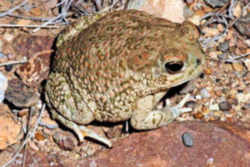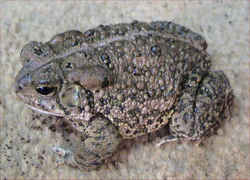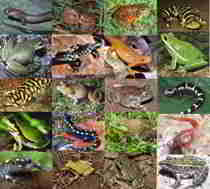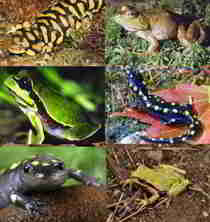
Texas Symbols
Texas State Amphibian
Texas Toad

(Bufo speciosus)
Adopted in June 19, 2009.
Rep. Bonnen filed House Concurrent Resolution No. 18 (HCR18) on January 13, 2009. On June 19, 2009, Governor Rick Perry signed House Concurrent Resolution No. 18, making the Texas toad the official amphibian of the State of Texas.
Texas State Amphibian: Texas Toad

The Texas Toad, (Bufo speciosus,) is a medium size toad reaching lengths in excess of 3 inches. They are generally a gray to brown coloration with a scattering of dark blotches on their back. Unlike many other species, the Texas Toad has no middorsal stripe. The widely spaced parotid glands are about half as wide as they are long as seen in the photos on this page. The only really distinct characteristic of the Texas Toad are the 2 black tubercles on each of the hind feet.
Characteristics of the Texas Toad
Plump. Grayish/brown to olive. Green warts. Vocal sac covered by skin flap
- Round body, covered with small warts.
- Two black tubercles on hind feet; inner tubercle sickle-shaped.
- Cranial crests indistinct and widely separated, or absent.
- Oval parotoid glands
Voice
Trill. High-pitched.
Breeding
April-September. After rainfall in temporary pools, ditches and waterholes.
Habitat
Woodland, prairie grassland. This species prefers grassy flats, and is most abundant in the thornscrub habitat to our south, but it also occurs in rocky canyons. However, it is mostly absent from wooded areas.
Range
Texas. Also Oklahoma, New Mexico into Mexico.
Distribution:
his species occurs throughout the western 2/3s of Texas
Reproduction:
Breeding in Bufo speciosus occurs from April to September, after rains.
Discussion
Nocturnal. Burrows underground. Flattens against the ground when threatened
Official State Amphibian of Texas Named
Friday, 04 December 2009 22:47 | Written by TPWD Brownwood
With help from the Texas Parks and Wildlife Department, a group of Texas fourth graders successfully enabled the Texas legislature to name the Texas
Toad (Bufo speciosus) the official amphibian of Texas.
State Rep. Dennis Bonnen of Angleton paid a visit to Danbury Elementary School south of Houston near Brazosport in October to congratulate the children-now
fifth-graders-on their accomplishment. Bonnen was House sponsor of the enabling legislation.
"We now have a state amphibian because of Danbury," Bonnen said, according to Brazoria county newspaper The Facts. "Your children someday
will be able to look at Texas history and see that there is a state amphibian. You're going to be able to tell them, 'I did that.' This is a really
big deal. You're now a part of Texas history."
The process of choosing a state amphibian got underway last year, when TPWD biologists suggested five candidates for the state amphibian slot to the
Danbury fourth grade class: the Texas Toad, the barred tiger salamander, Strecker's chorus frog, the cliff-chirping frog and the Houston Toad. The
students broke into groups, and each group was assigned an animal to campaign for. The campaigns included signs, commercials and speeches, all leading
up to a final vote on Nov. 2, 2008-two days before their parents headed to the polls to vote in federal and state races. The Texas Toad squeaked by
with three votes over the second-place finisher, the barred tiger salamander.
The Texas Toad was the right amphibian for the job, said Texas Toad campaign spokes-student Hannah Spitler in an interview with The Facts. "It
has the word 'Texas' in its name."
Once the election drew to a close, the students contacted state Rep. Bonnen and asked him to introduce legislation in the state legislature that would
make the Texas Toad the official amphibian of Texas. The legislation passed the state House and Senate before it was signed by Gov. Rick Perry in June.
The designation calls attention to the imperiled status of many amphibians throughout the state and the nation. Amphibians serve as what biologists
call an "indicator species"-meaning that they can act as a barometer for the environmental health of a particular region.
"They have skin that is semi-permeable, not protected by scales or fur," said Leeann Linam, a TPWD biologist. "They lay their eggs in water
and have a semi-aquatic lifestyle, which makes them especially vulnerable to changes to the environment."
While the Texas Toad is not endangered-in fact, it is among the most widespread toad species in the state-many of Texas' native amphibian species,
including one of the Texas Toad's competitors in the state amphibian race, the Houston Toad, are endangered. TPWD regulations enacted in May 2007,
part of a broader effort to protect threatened turtle and amphibian species, prohibited the harvesting of the Texas Toad on public land or water for
commercial purposes. Another effort, Texas Amphibian Watch, enlists citizen scientists in an effort to keep a close watch on the condition of amphibian
species in the state.
"By having people in the field as volunteers, we can find out if there are declines or die-offs of frogs and toads," said Linam, who works with
the program. Since its inception in 2000, 70 citizen scientists have participated, reporting sightings of 41 of the state's 42 frog and toad species
from 127 sites in 87 counties across the state.
"What we offer is a free monitoring packet, a $5 CD of frog and toad calls and regular training workshops across the state," Linam said. Participants
are encouraged to adopt a frog pond and make regular observations there, as well as recording instances of deformed frogs, which can serve as an indicator
of an environmental disturbance. More information about the Texas Nature Tracker project, including downloadable monitoring packets and information
about each of Texas' frog and toad species, can be found on the Amphibian Watch Web site.
One of the earliest recorded cases of widespread frog malformations, which raised national attention to the role of frogs and toads as indicator species,
occurred in the mid-1990s when a group of Minnesota schoolchildren discovered a pond in which more than half of the leopard frogs had missing or extra
limbs. The finding raised national speculation that the deformities, and several similar cases nationwide, might have been caused by a pesticide or
other pollutant.
A 2007 study of the case by University of Colorado-Boulder biologists, however, both highlights the value of frogs and toads as visible markers of
sweeping environmental changes that can easily pass unnoticed by humans and points to the complex interrelationships that can exist within ecosystems.
According to the study, the deformities in the frogs were caused by cysts left by natural, microscopic parasites known as trematodes, which experienced
a sudden population boom along with another of its host species, a type of snail whose primary food source, algae, had become suddenly abundant. The
increased growth of the algae, in turn, had been fueled by phosphorous and nitrogen runoffs from fertilizers used on nearby farms and ranches.
"The research has implications for both worldwide amphibian declines and for a wide array of diseases potentially linked to nutrient pollution, including
cholera, malaria, West Nile virus and diseases affecting coral reefs," said the study's author, UCB biologist Pieter Johnson, in a statement from
the National Science Foundation, which funded the research.
Texas H.C.R. No. 18 House Concurrent Resolution
Rep. Bonnen filed House Concurrent Resolution No. 18 (HCR18) on January 13, 2009. On June 19, 2009, Governor Rick Perry signed House Concurrent Resolution No. 18, making the Texas toad the official amphibian of the State of Texas.
WHEREAS, The State of Texas traditionally has recognized a variety of official symbols as tangible representations of the proud
character and colorful heritage of the Lone Star State; and
WHEREAS, Select members of the animal kingdom, including the longhorn, the armadillo, and the Guadalupe bass, are among the species that have been
officially recognized, and their designation has served to draw attention to the great biological diversity of the Texas landscape and to highlight
creatures who are unique to or closely identified with the state; and
WHEREAS, The large variety of natural habitats in Texas as well as the state's central location on the North American continent have given it a rich
array of amphibians; of the many members of that class that share our lands and waters, one species comes immediately to the forefront as an especially
worthy symbol of the state: the Texas toad; and
WHEREAS, Aptly named, the Texas toad lives primarily in the Lone Star State, though it is also found in the neighboring areas of New Mexico, Oklahoma,
and northern Mexico; known by the scientific name Bufo speciosus, it is one of the most abundant toad species in Texas and resides in nearly all regions
of the state with the exception of the far eastern counties and parts of the western Panhandle; and
WHEREAS, Ranging in color from gray to brown with dark irregular markings, the Texas toad can grow to more than three inches in length and is easily
identified by the black tubercles on its hind feet and by the absence of the back stripe that is seen on many other toads; and
WHEREAS, These adaptable amphibians demonstrate the hardy determination that Texans are known for; in order to survive in a place where the sun is
fierce and water can be scarce, they are adept at taking refuge beneath rocks and in below-ground havens; while most well suited to live in areas of
sandy soil, they also thrive in other locales and are found in environments that range from desert to grasslands to wooded areas; and
WHEREAS, Relishing nothing more than a cooling shower, Texas toads emerge in huge numbers following a summer rain and head for the nearest pool of
water in hopes of finding a mate; the toads have a distinctive sound, with males emitting a call of explosive trills to charm their lady friends; and
WHEREAS, Possessing a Buddha-like visage, this notable creature is a common sight across much of Texas, and its indomitable spirit and unique relationship
with the state for which it was named make it a most appropriate symbol of the Lone Star State; now, therefore, be it
RESOLVED, That the 81st Legislature of the State of Texas hereby designate the Texas toad as the official State Amphibian of Texas.
Texas Law
The Texas toad was named the official state amphibian of the State of Texas by House Concurrent Resolution and is not, therefore, listed in the Texas Statutes.
Taxonomic Hierarchy: Texas Toad
Kingdom: Animalia
Phylum: Chordata
Class: Amphibia
Order: Anura
Family: Bufonidae
Genus: Bufo
Species: B. speciosus







